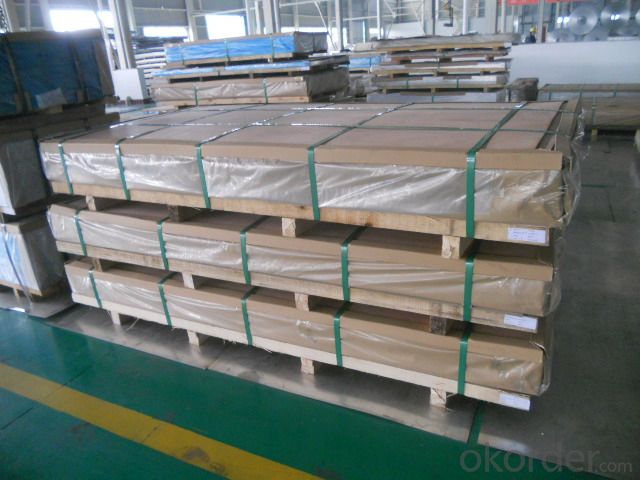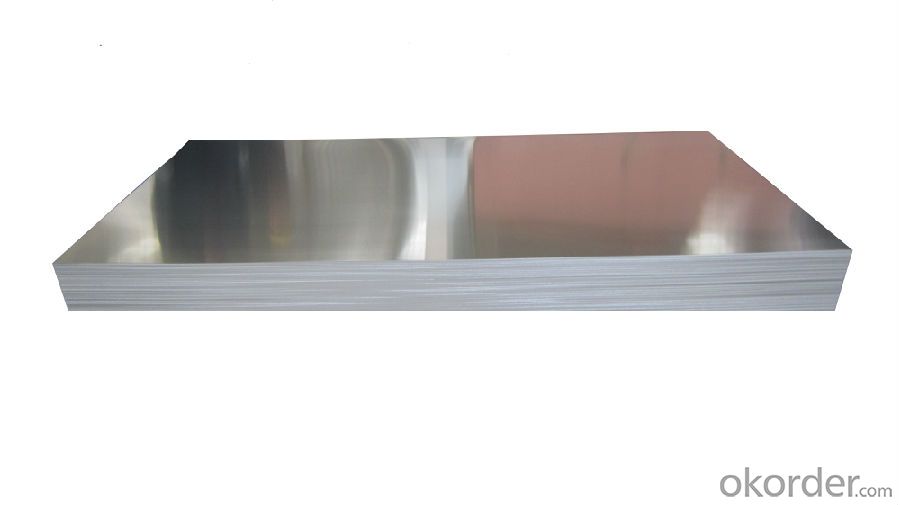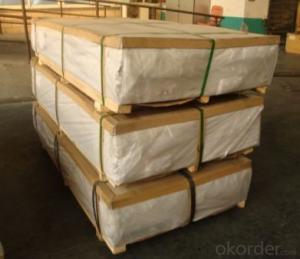Aluminium Plain Sheet for Construction and Curtain Wall
- Loading Port:
- Shanghai
- Payment Terms:
- TT OR LC
- Min Order Qty:
- 1 m.t
- Supply Capability:
- 5000 m.t/month
OKorder Service Pledge
OKorder Financial Service
You Might Also Like
3003-H14 Aluminum Sheet - (ASTM B209) Excellent weldability, formability, with good corrosion resistance make 3003 Aluminum Plate a popular and economical choice. 3003 Aluminum Plate has a smooth, shiny finish and is popular for many cosmetic and industrial applications, including: decorative trim, fuel tanks, food & chemical handling, trailer siding & roofing, etc.
Non-magnetic, Brinell = 40, Tensile = 22,000, Yield = 21,000 (+/-)
5052-H32 Aluminum Sheet - (ASTM B20) Superior corrosion resistance, good weldability, with excellent formability, makes 5052Aluminum Plate a common choice for chemical, marine or saltwater applications. 5052 Aluminum Plate applications include: tanks, drums, marine hardware, boat hulls, etc.
Non-magnetic, Brinell = 60, Tensile = 33,000, Yield = 28,000 (+/-)
6061-T651 Aluminum Sheet - (ASTM B209, QQ-A 250/11) Offers a combination of increased strength, corrosion resistance, and machinability making it the most widely used aluminum grade. 6061 Aluminum Plate is heat treatable, resists cracking due to stress, is easy to weld and machine, but limited on formability. 6061 Aluminum Plate is ideal for structural framing, base plates, gussetts, motorcycle & automotive parts, etc.
Non-magnetic, Brinell = 95, Tensile = 45,000, Yield = 40,000 (+/-)


- Q:How are aluminum sheets tested for quality and compliance with industry standards?
- Aluminum sheets are tested for quality and compliance with industry standards through a comprehensive set of tests and inspections. These tests ensure that the aluminum sheets meet the required specifications and performance criteria. One of the commonly used tests is the visual inspection, where the sheets are examined for any surface defects such as scratches, dents, or cracks. This is crucial to ensure a smooth and flawless appearance. Further, dimensional checks are performed to verify the thickness, width, and length of the sheets. Precise measurements are necessary to meet the specific requirements of the intended application. To assess the mechanical properties, various tests are conducted. Tensile strength tests evaluate the maximum load the aluminum sheet can withstand before breaking. This helps determine the sheet's structural integrity and its ability to withstand external forces. Similarly, hardness tests measure the sheet's resistance to indentation or penetration, providing insights into its durability and resistance to wear. Chemical composition analysis is also conducted to ensure that the aluminum sheets contain the necessary alloying elements within the specified limits. This analysis helps confirm that the material composition aligns with industry standards, as different alloy compositions can affect the sheets' mechanical properties and suitability for various applications. Surface integrity is evaluated through corrosion resistance tests, which assess the sheet's ability to withstand environmental factors such as moisture, chemicals, and temperature variations. This is particularly important for applications where aluminum sheets are exposed to corrosive substances or harsh environments. In addition to these tests, aluminum sheets may undergo non-destructive testing techniques such as ultrasonic testing or eddy current testing. These methods help identify internal defects or irregularities that may not be visible through visual inspection alone. Overall, a combination of visual inspections, dimensional checks, mechanical tests, chemical composition analysis, and surface integrity evaluations are employed to ensure that aluminum sheets meet the quality standards and compliance requirements set by the industry. These rigorous testing procedures guarantee that the sheets are fit for their intended purpose and meet the expectations of customers.
- Q:What are the different surface patterns or textures available for aluminum sheets?
- Aluminum sheets come in various surface patterns and textures, each designed for specific purposes and offering unique aesthetic appeal. Some commonly used surface patterns for aluminum sheets are as follows: 1. Smooth: These sheets have a flat and polished surface without any visible patterns or textures. They are ideal for applications that require a clean and sleek appearance, such as architectural elements or interior design. 2. Diamond Plate: These sheets have a raised diamond pattern on the surface, providing excellent traction and slip resistance. They are commonly used for flooring, stairs, ramps, and industrial applications where grip and durability are essential. 3. Brushed: These sheets have a consistent linear pattern created by brushing the surface with fine abrasive pads. This finish gives a satin-like appearance, making it popular for decorative purposes like signs, furniture, appliances, and automotive trim. 4. Stucco: These sheets have a raised pattern that resembles a stucco wall finish. The texture is achieved by embossing the sheet with a stucco roller, creating a rough and durable surface. Stucco patterned sheets are commonly used for exterior cladding, roofing, and decorative applications. 5. Hammered: These sheets have a unique texture that resembles the surface of hammered metal. The finish is achieved by imprinting the sheet with a pattern of small indentations using a hammer or similar tool. Hammered sheets are often used for decorative purposes, such as backsplashes, countertops, and art installations. 6. Perforated: These sheets have a pattern of small holes punched into the surface, allowing for airflow, light transmission, and sound absorption. They are commonly used for architectural elements, screens, filters, and ventilation systems. These examples represent just a fraction of the surface patterns and textures available for aluminum sheets. Each texture serves a specific purpose and offers distinct visual appeal, enabling a wide range of applications in various industries.
- Q:How does the surface treatment affect the corrosion resistance of aluminum sheet?
- Enhancing the corrosion resistance of aluminum sheet is greatly influenced by its surface treatment. Aluminum itself possesses inherent corrosion resistance due to the formation of a thin oxide layer on its surface. However, this oxide layer may not always be sufficient in safeguarding the metal against aggressive environments or harsh conditions. To significantly improve the corrosion resistance of aluminum sheet, various surface treatments such as anodizing, chromating, or painting can be employed. Anodizing involves the creation of a controlled oxide layer on the aluminum's surface through an electrochemical process. This layer exhibits high resistance to corrosion and effectively protects the metal from various corrosive agents. On the other hand, chromating involves the application of a chromate conversion coating that forms a thin film on the aluminum surface. This coating acts as a barrier, preventing the penetration of corrosive substances and subsequent oxidation. Additionally, it enhances the adhesion of subsequent paint or adhesive layers. Painting is another commonly utilized surface treatment for aluminum sheets. By applying a paint layer, the metal is not only shielded from corrosion but also acquires an aesthetically pleasing finish. The paint functions as a physical barrier that safeguards the aluminum against moisture, chemicals, and other corrosive elements. The selection of the appropriate surface treatment depends on the specific application and the desired level of corrosion resistance. Anodizing is often preferred in construction, automotive, and aerospace industries as it provides exceptional corrosion protection and enhances the appearance of the metal. Chromating is commonly utilized in electrical and electronic applications, as it offers both corrosion resistance and electrical conductivity. Painting is suitable for applications where both aesthetics and corrosion protection are of equal importance, such as architectural elements or consumer products. In conclusion, the corrosion resistance of aluminum sheet is significantly influenced by its surface treatment. Anodizing, chromating, and painting all contribute to enhancing the protective properties of aluminum against corrosion, thereby extending its lifespan and ensuring its durability in various environments.
- Q:Can aluminum sheets be used in construction?
- Yes, aluminum sheets can be used in construction. Aluminum is a versatile and lightweight material that possesses several beneficial properties for construction purposes. It is corrosion-resistant, making it suitable for both indoor and outdoor applications. Aluminum sheets also have high strength-to-weight ratio, meaning they offer strength and durability while remaining relatively lightweight, which can be advantageous in construction projects where weight is a concern. Additionally, aluminum is non-toxic and highly recyclable, making it an environmentally friendly choice. These factors, combined with its aesthetic appeal and ease of fabrication, make aluminum sheets a popular choice for various construction applications such as roofing, cladding, wall panels, window frames, and more.
- Q:Other then pop cans, what else is aluminum that can be recycled?
- Anything made of aluminum can be recycled. Aluminum cans are just a visible item that can be used for social engineering purposes. The cans also are very pure form of the metal. You will find aluminum in many things, from parts in your computer, major parts in your family car, pots, pans, kitchen items, tools, display items, structural supports for various things, boats, canoes, airplanes, and the list is long. Fact is, it would be difficult to find many items where aluminum was NOT used. Although everything that is metal that a magnet would not stick to, is not always aluminum. ANY metal can be recycled, and most metals can be sorted for recycling when you find a recycling plant that will buy the materials. Some of the metals need to be in large quantity, or weight in order to be worthwhile sorting. Some things like batteries can be sorted by general type. Some of those are easier to break down to component metals than others. Some have hazardous substances in them so need care in storage, and some have hazardous substances that need special care in shipping them. But they are exception.
- Q:I have a specific design I'd like to cut out of thin sheet metal (aluminum or tin) and I'm wondering how to make it more sturdy. The sheet metal is a bit flimsy. Can I strengthen it by heating it up (butane torch) and cooling it quickly?
- No. In fact, aluminum (and I believe tin) work harden when hammered - as do brass and copper and you heat to anneal and then you can cool fast or slow, still soft. Tin has a very low melting point and hitting it with a torch, especially if thin, will probably put a hole in it. The chances of you actually having tin sheet metal are very low - tin cans are zinc plated steel or some other coating. Steel does harden when quench, but heating tin or zinc coated metal is likely to damage the coating and perhaps give off noxious fumes - especially zinc.
- Q:Hey.How come iron rust and aluminium does not?DETAILED ANSWER PLEASE.I want to understand this...THANKS.
- Rust And Aluminum
- Q:I'm about to fix the aluminum wiring in my house using Alumiconn connection, so I know that every outlet and switch plate need to be done, do the light fixtures need to be done as well? And also does anything need to be done with the main circuit breaker?
- Aluminum twine, in and of itself, isn't the threat. you ought to purchase receptacles that are rated for AL/CU Aluminum and copper. If the twine is undamaged, replace the receptacle with an AL/CU rated receptacle, and be better careful how lots torque you place on the screws that carry the twine down. AN AL/CU rated receptacle costs around $3.50 compares to the cheap $0.fifty 9 copper purely rated junkers at domicile Depot? you do no longer could replace all the aluminum wiring. In different situations, you are able to couple AL to CU twine with approved twine Nuts that are rated for AL/CU. BE better careful approximately BEND RADIUS AND TORQUE specs!
- Q:Can 101 aluminum sheets be used in the production of decorative panels?
- Indeed, decorative panels can be produced with the use of 101 aluminum sheets. Recognized for its exceptional formability and resistance to corrosion, 101 aluminum stands out as a commercially pure alloy. This alloy's remarkable attributes render it appropriate for diverse applications, decorative panels being one of them. The aluminum sheets have the capacity to be effortlessly molded, trimmed, and crafted, enabling the formation of intricate designs and patterns for ornamental intentions. Furthermore, the corrosion resistance of 101 aluminum guarantees that the panels will retain their visual appeal throughout time, even when exposed to outdoor conditions or environments with high moisture levels.
- Q:Could two pieces of aluminum sheets be welded together?
- youcan use aluminium soldering,what do you want to weld?
1. Manufacturer Overview |
|
|---|---|
| Location | |
| Year Established | |
| Annual Output Value | |
| Main Markets | |
| Company Certifications | |
2. Manufacturer Certificates |
|
|---|---|
| a) Certification Name | |
| Range | |
| Reference | |
| Validity Period | |
3. Manufacturer Capability |
|
|---|---|
| a)Trade Capacity | |
| Nearest Port | |
| Export Percentage | |
| No.of Employees in Trade Department | |
| Language Spoken: | |
| b)Factory Information | |
| Factory Size: | |
| No. of Production Lines | |
| Contract Manufacturing | |
| Product Price Range | |
Send your message to us
Aluminium Plain Sheet for Construction and Curtain Wall
- Loading Port:
- Shanghai
- Payment Terms:
- TT OR LC
- Min Order Qty:
- 1 m.t
- Supply Capability:
- 5000 m.t/month
OKorder Service Pledge
OKorder Financial Service
Similar products
New products
Hot products
Related keywords




























